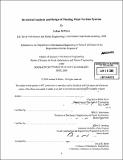| dc.contributor.advisor | Paul D. Sclavounos. | en_US |
| dc.contributor.author | Di Pietro, Joshua (Joshua Michael) | en_US |
| dc.contributor.other | Massachusetts Institute of Technology. Dept. of Mechanical Engineering. | en_US |
| dc.date.accessioned | 2010-01-07T20:55:25Z | |
| dc.date.available | 2010-01-07T20:55:25Z | |
| dc.date.copyright | 2009 | en_US |
| dc.date.issued | 2009 | en_US |
| dc.identifier.uri | http://hdl.handle.net/1721.1/50575 | |
| dc.description | Thesis (S.M. in Mechanical Engineering and Naval Architecture and Marine Engineering)--Massachusetts Institute of Technology, Dept. of Mechanical Engineering, 2009. | en_US |
| dc.description | Includes bibliographical references (p. 139-140). | en_US |
| dc.description.abstract | As oil supply rates approach potential maximums and the global detrimental effects of carbon emitting energy technology are becoming more comprehensively understood, the world is searching for environmentally benign energy technology which can be reliably and economically harvested. Deep water offshore wind is a vast, reliable and potentially economical energy source which remains globally untapped. In order to harvest this resource, potential floating turbine systems must be analyzed and designed for economic production and deployment, reliable operation, and adequate service life. The Laboratory of Ship and Platform Flow (LSPF) has created trusted hydrodynamic modeling software used to perform a Pareto Optimization which resulted in an optimized Floating Wind Turbine (FWT) design which is a Tension Leg Platform (TLP); hereto called MIT TLP-1. This thesis details the structural design aspects of Floating Wind Turbines (FWT) in a rationally based optimization approach for incorporation into existing LSPF hydrodynamic optimization approaches. A steel structural design is created based on the geometry and loading of the MIT TLP-1 for a 10m significant wave height. The design is based on similar system analysis, classic linear structural theory, American Bureau of Shipping rules and American Petroleum Institute recommended practices. The design is verified using Finite Element Analysis (FEA). The results of this work show that the MIT TLP-1 design is technically feasible from a structural integrity, performance and producibility standpoint. | en_US |
| dc.description.statementofresponsibility | by Joshua Di Pietro. | en_US |
| dc.format.extent | 140 p. | en_US |
| dc.language.iso | eng | en_US |
| dc.publisher | Massachusetts Institute of Technology | en_US |
| dc.rights | M.I.T. theses are protected by
copyright. They may be viewed from this source for any purpose, but
reproduction or distribution in any format is prohibited without written
permission. See provided URL for inquiries about permission. | en_US |
| dc.rights.uri | http://dspace.mit.edu/handle/1721.1/7582 | en_US |
| dc.subject | Mechanical Engineering. | en_US |
| dc.title | Structural analysis and design of floating wind turbine systems | en_US |
| dc.type | Thesis | en_US |
| dc.description.degree | S.M.in Mechanical Engineering and Naval Architecture and Marine Engineering | en_US |
| dc.contributor.department | Massachusetts Institute of Technology. Department of Mechanical Engineering | |
| dc.identifier.oclc | 464237728 | en_US |
